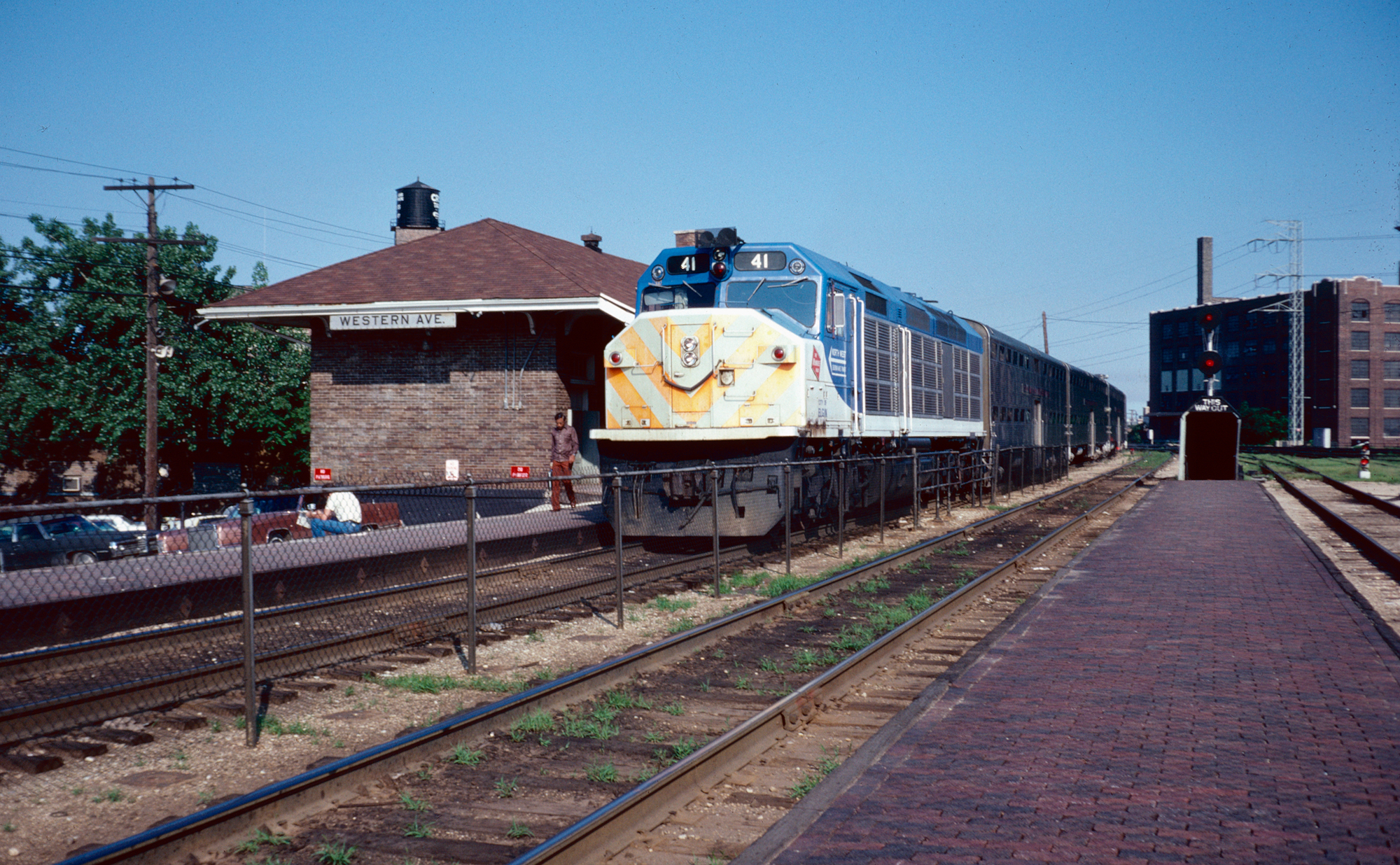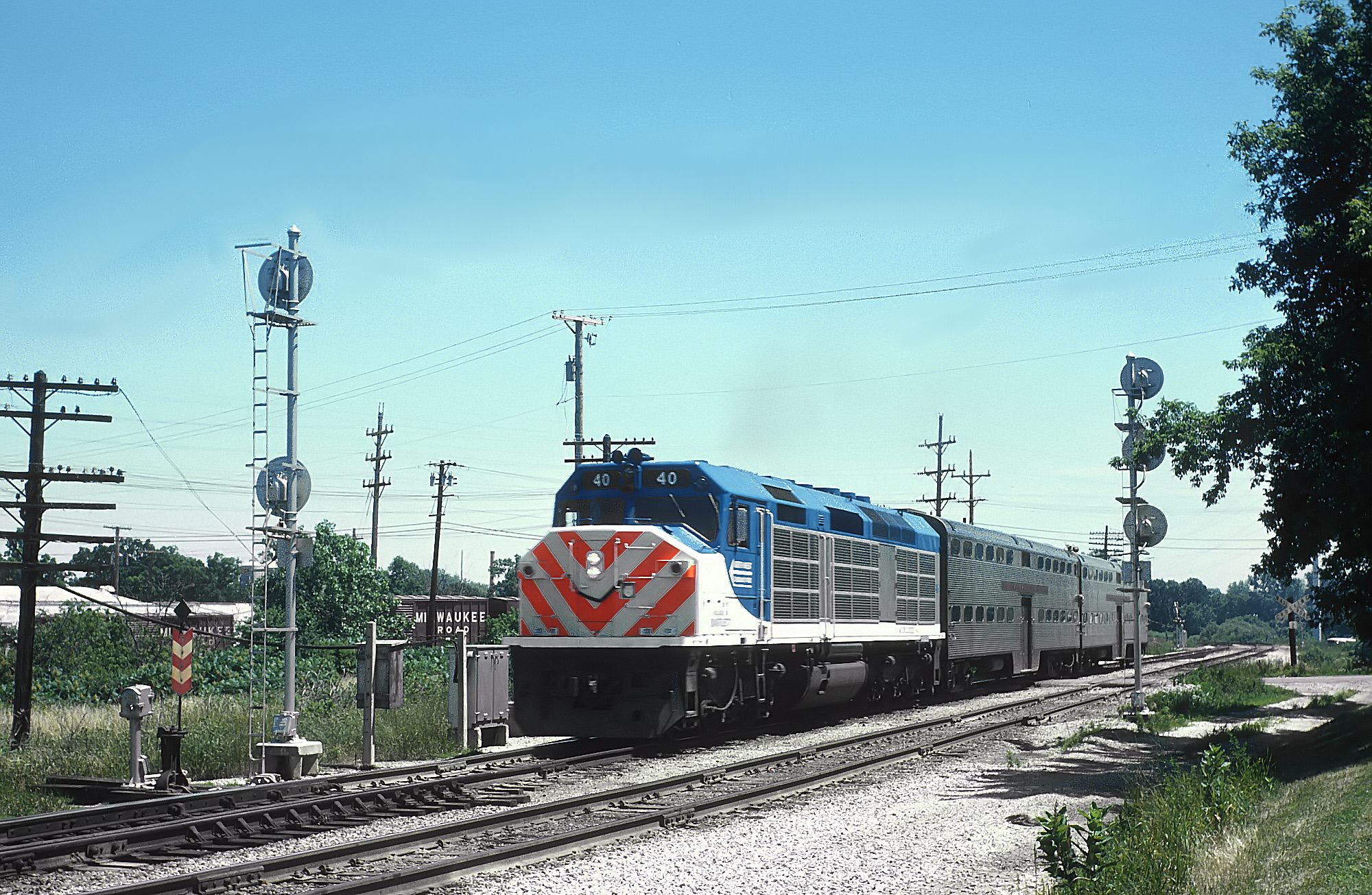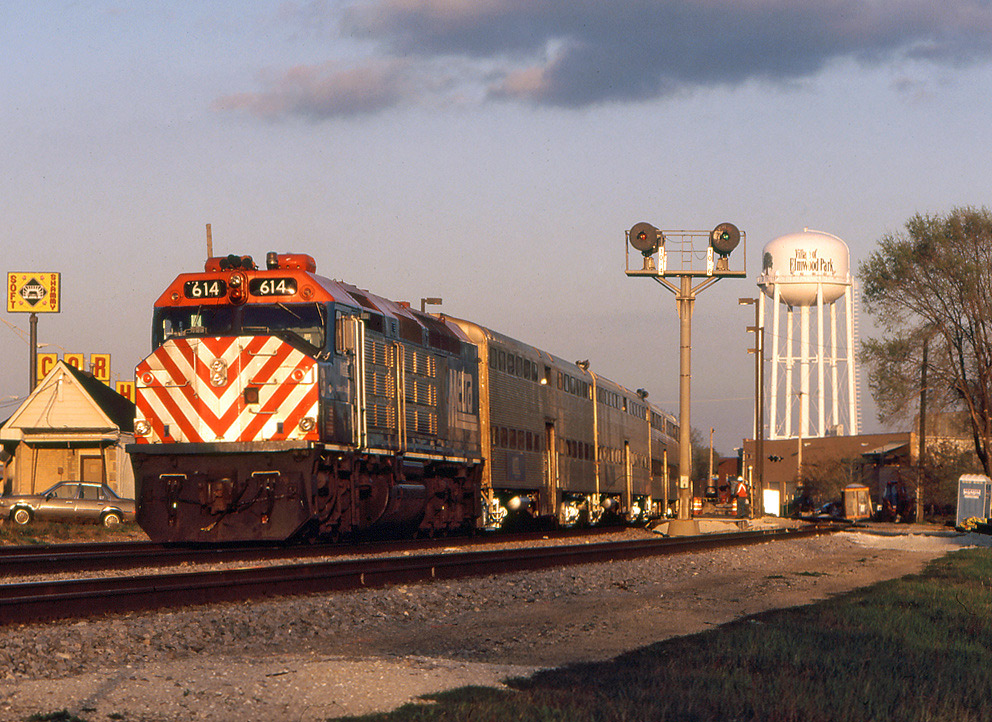EMD "F40C" Locomotives: Specs, Roster, History
Last revised: December 16, 2024
By: Adam Burns
The F40C was EMD's commuter version of its SDP40F road variant built for Amtrak in 1973/1974. Featuring a HEP alternator, in place of the latter's steam generator, the F40C was four feet shorter utilizing a standard SD40-2 frame.
The SDP40F suffered from a string of a derailments soon after it entered service, the cause of which required an extensive investigation by multiple parties. The F40C, however, dealt with no such issues. It proved itself a reliable and rugged locomotive that spent 30 years in service before the final units were retired from Metra in 2004.
Nevertheless, the SDP40F's reputation resulted in few sales for the F40C. Ultimately, only 15 were purchased for Chicago area commuter service on the Milwaukee Road. The locomotives originally featured Milwaukee placards but were later painted into Metra colors during the 1980s.
After the commuter agency acquired new MP36PH-3S between 2002 and 2004, the fleet of F40Cs were retired. As of this writing, #611 and #614 remain on the roster for parts.
Photos
 Milwaukee Road F40C #41 works suburban service at Western Avenue (Chicago) on July 23, 1980. Photographer unknown. American-Rails.com collection.
Milwaukee Road F40C #41 works suburban service at Western Avenue (Chicago) on July 23, 1980. Photographer unknown. American-Rails.com collection.Overview
When Amtrak began service on May 1, 1971 the new national passenger carrier had no new equipment of its own. Instead, it relied solely on handed down cars and locomotives from railroads which initially elected to join.
Unfortunately, nearly all of this was decades old and worn out; it included models like Electro-Motive E8s and E9s dating back to the 1950s or early 1960s as well as Pullman/Budd/American Car & Foundry cars of nearly the same vintage.
Amtrak's first new road power included a large fleet of 150 locomotives purchased from EMD between 1973 and 1974, the SDP40F. This model sported the builder's latest "streamlined" carbody, the cowl design.
The new styling was much more boxy, and less elegant, than the classic "bull dog" nose design; smooth beveling and streamlined, rounded curves was replaced with a rectangular nose, notched windshields, and hard lines.
As Greg McDonnell notes in his book, "Locomotives: The Modern Diesel & Electric Reference," outwardly the SDP40F looked similar to the FP45 of 1967. However, internally the model was essentially a shrouded SD40-2 sporting a stretched frame - also used on the FP45 - to house a steam generator and the necessary water supply.
It featured EMD's latest prime mover, the 16-cylinder model 645E3 and modified, hollow-bolster HT-C trucks. The 150 examples were acquired between June, 1973 and August, 1974.
Unfortunately, Amtrak's new power immediately ran into problems, experiencing more than a dozen derailments by early 1977.
Following significant investigations by the Association of American Railroads (AAR), Amtrak, the Federal Railroad Administration, and Electro-Motive, Louis Marre notes in his book, "The Contemporary Diesel Spotters Guide," it was discovered most derailments had occurred when a train entered a curve of around 2 degrees at 40 to 60 mph.
Significant testing at the time could never determine the cause. It was eventually determined the sloshing of water in the on-board water supply created just enough lateral motion to cause the locomotives to derail. EMD found a solution to the problem but Amtrak had lost trust in the model.
The Santa Fe would later acquire 18 examples on trade in, had their steam generators and water supply removed, installed front steps and platforms, and were redesignated as SDF40-2s for freight service. Interestingly, the railroad never experience any problems with the locomotives.
In his book, "A Field Guide To Trains," author Gerald Foster notes that during their second trip to the shops the units also had their noses notched for easier boarding.
Nine months after Amtrak took delivery of its first SDP40Fs, Chicago's mass transit districts (which preceded the RTA) acquired their first F40Cs. These locomotives were commuter variants of the SDP40F.
They were nearly four feet shorter and equipped with 500 kilowatt alternators in place of steam generators. This new HEP (Head-End Power) technology was much more efficient and operated all of the train's essentials including lighting, heating, and air-conditioning.
 Milwaukee Road F40C #40 leads a pair of gallery suburban cars at Elgin, Illinois in October, 1974. Rick Burn photo.
Milwaukee Road F40C #40 leads a pair of gallery suburban cars at Elgin, Illinois in October, 1974. Rick Burn photo.Locomotive Names (Metra)
| Metra Road Number | Name |
|---|---|
| 600 | Village of Bartlett |
| 601 | City of Elgin |
| 602 | Village of Bensenville |
| 603 | Village of Schaumburg |
| 604 | Village of Elmwood Park |
| 605 | Village of Hanover Park |
| 606 | Village of Itasca |
| 607 | Village of River Grove |
| 608 | Village of Roselle |
| 609 | Village of Streamwood |
| 610 | City of Wood Dale |
| 611 | Village of Ontarioville |
| 612 | State of Illinois |
| 613 | Village of Round Lake |
| 614 | Edward F. Brabec |
Data Sheet and Specifications
| Entered Production | 3/1974 (Milwaukee Road #40) |
| Years Produced | 3/1974 - 5/1974 |
| Engine | 645E3 |
| Engine Builder | GM |
| Horsepower | 3200 |
| RPM | 800 |
| Cylinders | 16 |
| Length | 68' 10" |
| Height (Top Of Rail To Top Of Cab) | 15' 7 ½" |
| Width | 10' 4" |
| Weight | 364,000 Lbs |
| Fuel Capacity | 3,200 Gallons |
| Air Compressor | Gardner-Denver |
| Air Compressor Model | WBO |
| Air Brake Manufacturer | Westinghouse |
| Air Brake Schedule | 26L |
| Trucks | C-C |
| Truck Type | FT-C Hollow Bolster |
| Truck Wheelbase | 13' 7" |
| Wheel Size | 40" |
| Traction Motors | D77/D78 (6), GM |
| Primary Generator | AR10, GM |
| Alternator | GMD14 |
| HEP | AR4125 (Vapor-Clarkson) |
| MU (Multiple-Unit) | Yes |
| Dynamic Brakes | Yes |
| Gear Ratio | 59:15 |
| Tractive Effort (Starting) | 65,000 Lbs at 25% |
| Tractive Effort (Continuous) | 38,240 Lbs at 16.1 mph |
| Top Speed | 95 mph |
Production Roster
| Owner | Road Numbers | Serial Numbers | Completion Date |
|---|---|---|---|
| Milwaukee Road/Northwest Suburban Mass Transit District | 40-52 | 73612-1 thru 73612-13 | 3/1974-5/1974 |
| Milwaukee Road/North Suburban Mass Transit District | 53-54 | 73689-1, 73689-2 | 5/1974 |
 Metra F40C #614 works suburban service at Elmwood Park, Illinois along Canadian Pacific's Elgin Subdivision on April 19, 2004. Wade Massie photo.
Metra F40C #614 works suburban service at Elmwood Park, Illinois along Canadian Pacific's Elgin Subdivision on April 19, 2004. Wade Massie photo.At the time of the F40Cs' delivery, Chicago had not yet established the Regional Transportation Authority. With railroads threatening to discontinue commuter trains, communities along Chicago's four notable commuter lines formed suburban mass transit districts to obtain federal and state funding for new equipment and other improvements. The districts would own this new equipment.
The four included:
- Chicago South Suburban Mass Transit District (CSSMTD)/Illinois Central
- West Suburban Mass Transit District (WSMTD)/Burlington Northern
- Northwest Suburban Mass Transit District (NWSMTD)/Milwaukee Road's West Line.
- North Suburban Mass Transit District (Nortran)/Milwaukee Road's North Line
The latter two districts acquired a total of fifteen F40Cs; thirteen went to NWSMTD while two were acquired by Nortran between March and May, 1974.
Spotting Features
Aside from its shorter length, the F40C is easily distinguishable from an SDP40F via corrugated stainless-steel panels on the carbody. The locomotives featured a blue and white livery with district logos just under the cab windows.
In addition, the Milwaukee Road's placard was placed on the nose. The F40Cs spent their entire careers on the Milwaukee Road between Chicago, Fox Lake, and Elgin until the company's 1977 bankruptcy.
In 1982 the RTA formed the Northeast Illinois Regional Commuter Railroad Corporation to continue commuter service over the railroad's lines (as well as those formerly operated by the liquidated Rock Island).
The newly formed Metra formally took over operations in 1984 and continued operating most of the F40Cs until 2004 when newly acquired M36PH-3S from Motive Power took over their assignments.
Sources
- Foster, Gerald. A Field Guide To Trains. New York: Houghton Mifflin, 1996.
- Marre, Louis A. and Pinkepank, Jerry A. Contemporary Diesel Spotter's Guide, The: A Comprehensive Reference Manual To Locomotives Since 1972. Milwaukee: Kalmbach Publishing Company, 1989.
- Marre, Louis A. Contemporary Diesel Spotter's Guide, The: A Comprehensive Reference Manual To Locomotives Since 1972, Including Rebuilding, Upgrading, And Leasing Programs (2nd Edition). Milwaukee: Kalmbach Publishing Company, 1995.
- McDonnell, Greg. Locomotives: The Modern Diesel & Electric Reference, 2nd Edition. Buffalo: Boston Mills Press/Firefly Books, 2015.
- Solomon, Brian. EMD Locomotives. Minneapolis: MBI Publishing Company, 2006.
Recent Articles
-
Alabama's - Wine Tasting - Train Rides
Jan 10, 26 09:29 AM
While the state might not be the first to come to mind when one thinks of wine or train travel, the unique concept of wine tasting trains adds a refreshing twist to the Alabama tourism scene. -
Maryland Dinner Train Rides At WMSR!
Jan 10, 26 09:13 AM
The Western Maryland Scenic Railroad (WMSR) has become one of the Mid-Atlantic’s signature heritage operations—equal parts mountain railroad, living museum, and “special-occasion” night out. -
Arkansas Dinner Train Rides On The A&M!
Jan 10, 26 09:11 AM
If you want a railroad experience that feels equal parts “working short line” and “time machine,” the Arkansas & Missouri Railroad (A&M) delivers in a way few modern operations can. -
South Dakota's - Murder Mystery - Dinner Train Rides
Jan 10, 26 09:08 AM
While the state currently does not offer any murder mystery dinner train rides, the popular "1880 Train" at the Black Hills Central recently hosted these popular trips! -
Wisconsin's - Murder Mystery - Dinner Train Rides
Jan 10, 26 09:07 AM
Whether you're a fan of mystery novels or simply relish a night of theatrical entertainment, Wisconsin's murder mystery dinner trains promise an unforgettable adventure. -
Missouri's - Murder Mystery - Dinner Train Rides
Jan 10, 26 09:05 AM
Missouri, with its rich history and scenic landscapes, is home to one location hosting these unique excursion experiences. -
Washington ~ Murder Mystery ~ Dinner Train Rides
Jan 10, 26 09:04 AM
This article delves into what makes murder mystery dinner train rides in Washington State such a captivating experience. -
Kentucky Scenic Train Rides At KRM!
Jan 09, 26 11:13 PM
Located in the small town of New Haven the Kentucky Railway Museum offers a combination of historic equipment and popular excursions. -
Washington "Wine Tasting" Train Rides
Jan 09, 26 08:53 PM
Here’s a detailed look at where and how to ride, what to expect, and practical tips to make the most of wine tasting by rail in Washington. -
Kentucky's - Wine Tasting - Train Rides
Jan 09, 26 08:21 PM
Kentucky, often celebrated for its rolling pastures, thoroughbred horses, and bourbon legacy, has been cultivating another gem in its storied landscapes; enjoying wine by rail. -
Kentucky's - Murder Mystery - Dinner Train Rides
Jan 09, 26 01:12 PM
In the realm of unique travel experiences, Kentucky offers an enchanting twist that entices both locals and tourists alike: murder mystery dinner train rides. -
Utah's - Murder Mystery - Dinner Train Rides
Jan 09, 26 01:05 PM
This article highlights the murder mystery dinner trains currently avaliable in the state of Utah! -
North Carolina Dinner Train Rides At NCTM!
Jan 09, 26 12:51 PM
Tucked into the Piedmont town of Spencer, the North Carolina Transportation Museum is the kind of place that feels less like a typical museum and more like a living rail yard that never quite stopped… -
Tennessee Dinner Train Rides At The TVRM!
Jan 09, 26 12:39 PM
Tucked into East Chattanooga, the Tennessee Valley Railroad Museum (TVRM) is less a “museum you walk through” and more a railroad you step aboard. -
New York Scenic Train Rides On The A&A!
Jan 09, 26 11:20 AM
The A&A is both a common-carrier short line moving freight and a heritage railroad hosting popular excursion trains, all on the same storied right-of-way. -
Pennsylvania Scenic Train Rides In Hollidaysburg!
Jan 09, 26 11:14 AM
Tucked into the Juniata River valley just south of Altoona, the Everett Railroad offers one of the most approachable—and photogenic—heritage-rail experiences in Pennsylvania -
Montana Dinner Train Rides Near Lewistown!
Jan 08, 26 03:03 PM
The Charlie Russell Chew Choo turns an ordinary rail trip into an evening event: scenery, storytelling, live entertainment, and a hearty dinner served as the train rumbles across trestles and into a t… -
Alabama's - Murder Mystery - Dinner Train Rides
Jan 08, 26 02:19 PM
There is currently one location in the state offering a murder mystery dinner experience, the Wales West Light Railway! -
Rhode Island's - Murder Mystery - Dinner Train Rides
Jan 08, 26 01:43 PM
Let's dive into the enigmatic world of murder mystery dinner train rides in Rhode Island, where each journey promises excitement, laughter, and a challenge for your inner detective. -
Florida's - Wine Tasting - Train Rides
Jan 08, 26 01:13 PM
Wine by train not only showcases the beauty of Florida's lesser-known regions but also celebrate the growing importance of local wineries and vineyards.


















